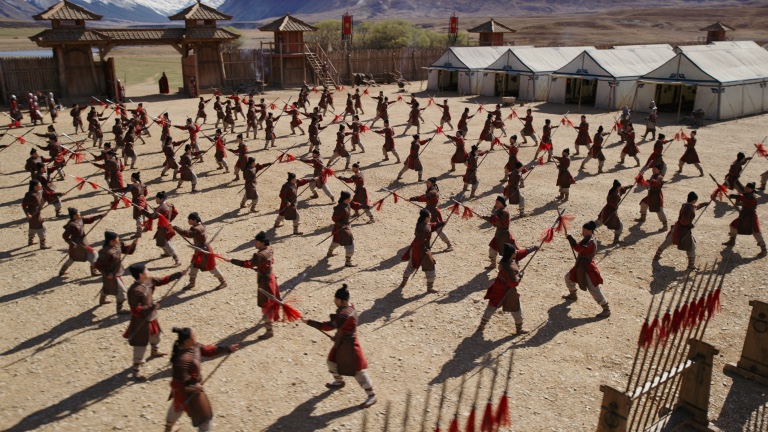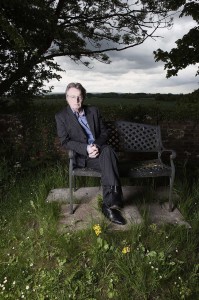
History Channel’s Vikings is a meticulously detailed saga that traces the exploits of legendary hero Ragnar Lothbrok on his rise to become leader of the Norse tribes. Known for his historical dramas, including the Oscar-nominated feature film, Elizabeth, starring Cate Blanchett, showrunner and creator Michael Hirst has written all of the episodes for the series.
Although Hirst has spent many years writing screenplays, he revealed that however close he was to a film’s director, as a writer he was not welcomed on set. “The director is God on a movie. On TV the wonderful thing that I discovered was that the show runner was respected,” said Hirst. “It’s changed my whole perspective about writing for TV. Obviously now is the golden age of TV drama, but it really has been a huge thing for me to switch from movies to TV.”
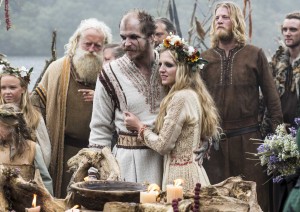
Script writing is a very condensed format. Nevertheless, the writer must be able to set-up a certain amount of detail in a scene, especially a historic drama where the reader is not familiar with the period and culture. “American scripts are all dialog, so there is very little printed about what the environment of a scene is, what it looks like. It’s all to do with how people interact,” commented Hirst. “I’m very different from that. I do describe how the scene looks and often what my influence has been. Sometimes it’s a painting, sometimes it’s a song. It’s just to help the set designer and the costume designer get a feel for what I’m thinking.”
As show runner, Hirst has his hand in all creative decisions for the show. Because of the budgetary limitations of television, especially when compared to films, they have to work through design problems to achieve story-appropriate solutions. Hirst loves the open-minded collaboration with his crew. He pushes his team in the direction he wants them to go, but wants to be surprised by their ideas. “They are creative people. They come up with fantastic variations of things,” said Hirst. “To me it’s a wonderful creative collaboration.”
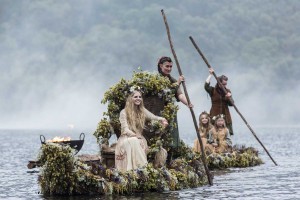 Hirst worked with costume designer and three-time Emmy winner, Joan Bergin, on The Tudors. That series, as well as Vikings, was shot in Ireland. In addition to Bergin, he assembled the crew that worked on Braveheart. “This is a movie crew. It’s not a TV crew,” explained Hirst. “They are exceptionally brilliant. I don’t think we could have shot this anywhere except in Ireland because of the challenges.”
Hirst worked with costume designer and three-time Emmy winner, Joan Bergin, on The Tudors. That series, as well as Vikings, was shot in Ireland. In addition to Bergin, he assembled the crew that worked on Braveheart. “This is a movie crew. It’s not a TV crew,” explained Hirst. “They are exceptionally brilliant. I don’t think we could have shot this anywhere except in Ireland because of the challenges.”
Production designer Tom Conroy did the original visuals and ran the art department. Mark Geraghty took over the production design and expanded the vision. The town that Ragnar rules was constructed on the shores of a volcanic lake on a vast estate south of Dublin owned by members of the Guinness family.
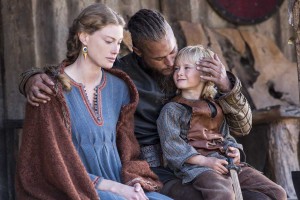 “When you come down from the top of the mountain into Luggala you see the lake, and you see the boat, and you see the town of Kattega, it is so amazing, so beautiful, you think this is real. This is what it looked like,” explained Hirst. “Then you see all the extras – there are like two thousand Viking extras. Sometimes it’s blowing up a storm because the Irish weather is changeable and they shoot through the storms. I walk on the set and these two thousand extras will say, ‘Hello, Michael.’ It’s fantastic. Isn’t that wonderful? They all feel part of it. They’re all dressed as Vikings. Of course, Ireland was a Viking country. They’re all just reliving their past.”
“When you come down from the top of the mountain into Luggala you see the lake, and you see the boat, and you see the town of Kattega, it is so amazing, so beautiful, you think this is real. This is what it looked like,” explained Hirst. “Then you see all the extras – there are like two thousand Viking extras. Sometimes it’s blowing up a storm because the Irish weather is changeable and they shoot through the storms. I walk on the set and these two thousand extras will say, ‘Hello, Michael.’ It’s fantastic. Isn’t that wonderful? They all feel part of it. They’re all dressed as Vikings. Of course, Ireland was a Viking country. They’re all just reliving their past.”
Early this year, hair department head, Dee Corcoran won best period hair styling on an episodic television series for Vikings (2013) from the Hollywood Makeup Artist and Hair Stylist Guild. “These people are geniuses,” said Hirst. “I can’t say enough about them. The whole production machine, and in Ireland it’s a machine, it just works. They switch it on and it powers forward. Morgan O’Sullivan [executive producer] is my partner in Ireland and he makes sure everything works. One of the amazing things about Vikings is that it’s never gone over budget. And it’s all on the screen.”
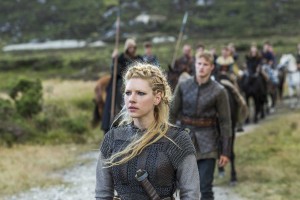 The company shoots four scenes a day, “come hell or high water.” There is no “bad apple” on either side of the camera. Everyone, including the cast and extras, are focused on moving forward. The call starts at 6 a.m. and ends at night when they are finished with the scenes that must be completed.
The company shoots four scenes a day, “come hell or high water.” There is no “bad apple” on either side of the camera. Everyone, including the cast and extras, are focused on moving forward. The call starts at 6 a.m. and ends at night when they are finished with the scenes that must be completed.
Despite the tough shooting schedule, there is no apparent sacrifice of quality cinematography. The look of the show is filmic in scope, avoiding the more typical television-style talking heads on interior sets. After the first season, Irish cinematographer P.J. Dillon took over the show from John S. Bartley. Dillon is young and was looking to break through. “He’s absolutely wonderful,” said Hirst. “Honestly, for me it’s humbling to see these guys and women. They’re the best at everything. I’m so glad that I’m in the middle of that, working with so many talented people.”
In getting his vision from the page to the screen, Hirst does not want to force his ideas on the directors that guide the production process. “I write things that are there to be discussed. We evolve a show. I talk to the actors. I talk to the directors. I talk to the heads of the departments. I talk to Joan Berkin a lot about how it looks. I talk about what we build. It’s like an adventure,” said Hirst. “I don’t want to impose anything. I don’t know anything. I’m just offering stuff. Historically, I’ve done my research, but now I’m giving it to you.”
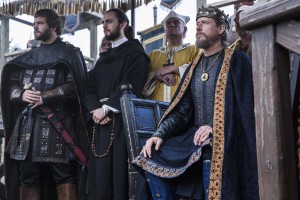 Ultimately, Hirst allows his creative team to “make it real.” Being close to the production, he is highly aware of the great lengths that his crewmembers go to source every element in order to make the story as real as it can be.
Ultimately, Hirst allows his creative team to “make it real.” Being close to the production, he is highly aware of the great lengths that his crewmembers go to source every element in order to make the story as real as it can be.
Postproduction for the show is all done in Canada, with the help of executive producer Sheila Hockin, who worked on The Tudors with Hirst. Sound designer, Jane Tattersall, is also based in Toronto, as are the picture editors.
The difficult job for the picture editors is the necessity of cutting two versions of each episode because of the demands of network television. The History Channel version is forty-three minutes long with five breaks, cliffhangers along the way and various rules as to what can be shown. The European or world version is ten minutes longer, so more can be shown and the episode can breath. “This causes a lot of discussion about what you have to sacrifice,” revealed Hirst. “The editors and I spend a lot of sorrowful evenings saying, ‘We have to sacrifice that,’ even though we don’t want to do it.”
When Hirst first started to think about Vikings, he read extensively and conferred with a historical consultant. They discovered Ragnar Lothbrok, the first great Viking leader. What excited Hirst about Lothbrok were not only the leader’s feats, like attacking both England and France, but the fact that he had lots of sons, and those sons attacked and settled in Ireland, France and Russia. They also colonized Greenland and Iceland and arrived on the coast of North America hundreds of years before Columbus. This extended family history lends itself to a continuing series.
“It may run out of steam. You don’t know. What people respond to, and what they care about, is the characters. As long as they’re invested in the characters, you can take them anywhere” Hirst continued, “It’s about families. Who knew that the Vikings had family relationships, that husbands loved their wives, that they loved their children? That’s the glue that keeps people attached to the series. It’s not a history lesson. It’s about people. Hopefully we are in for a long adventurous voyage.”





